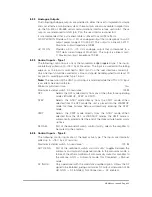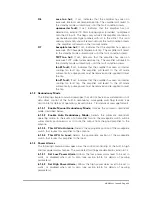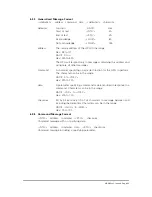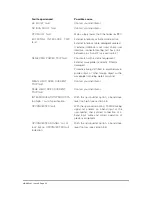
6
RS-485 SERIAL BUS
6.1
General Description and Features
The amplifier (HPA) is equipped with a RS-485 interface allowing connection as a
slave to an asynchronous, half-duplex, multi-drop, four-wire bus. This gives full
remote control and monitoring of the HPA as part of an integrated system.
The following section describes the main features, protocols and operation of the
HPA with the multi-drop serial bus.
6.1.1
HPA Type?
A data request command that prompts a response giving the amplifier type number
and the software issue (see section 6.4.3).
6.1.2
Status?
A data request command that prompts a response of 7 data bytes, within which the
status flags are contained (see section 6.4.3). The following list summarises the
status flags available on the 7 data bytes:
D1
summary fault;
If set, indicates that the amplifier has seen at least one
of the fault conditions described in this section. The amplifier operation
and reset conditions will be dependent upon the fault present.
transmitting;
If set, indicates that the amplifier is operating in the
transmit mode (full details of the operating modes are given in
section 4.3).
standby;
If set, indicates that the amplifier is operating in the standby
mode (full details of the operating modes are given in section 4.3).
warm-up;
If set, indicates that the amplifier is operating in the warm-
up mode (full details of the operating modes are given in section 4.3).
off;
If set, indicates that the amplifier is operating in the off mode
(full details of the operating modes are given in section 4.3).
D2
output to antenna;
When using the redundant switch control
feature, if set, indicates that the amplifier is routed to the Antenna. If
not set, indicates that the amplifier is routed to the Load. See
section 6.1.3 for details on the operation of the redundant switch
control feature.
auto-redundancy;
If set, indicates that the automatic mode for
redundant switch control is enabled. If not set, indicates that the
manual mode for redundant switch control is enabled. See section
6.1.3 for details on the operation of the redundant switch control
feature.
power too high;
If set, indicates that the high power alarm is set and
that the RF output power is above the alarm level. The amplifier will
remain in the transmit mode, but with the RF inhibited, until either:
i/
the RF output power falls below the alarm level (decrease the
RF input power or increase the internal digital attenuator, if
fitted) and an ‘RF enable’ request is sent to clear the ‘RF
inhibit’ or
ii/
the high power alarm is disabled (see section 6.1.4.2).
HBN63xx-1, Issue 8, Page 27
















































